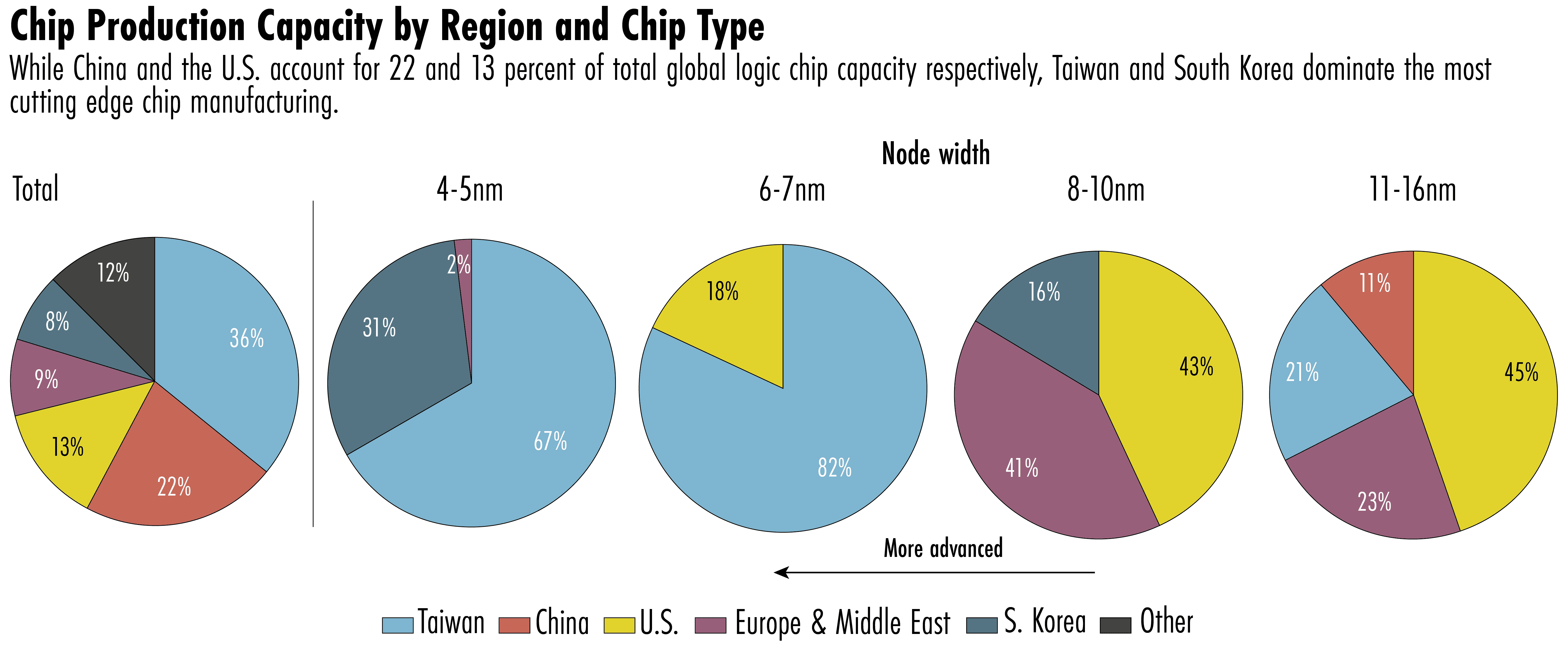
Last week, Congress passed a landmark $250 billion bill aimed at boosting America’s chipmaking capacity, embracing a plan that supporters say will help the U.S. take on China in this critical industry.
But what of the rest of Congress’ China plans? While expansive in its spending, the final bill dropped several measures initially planned as part of its broader set of “China competition” bills. Some experts are worried that certain dropped provisions may undercut the effectiveness of the chips legislation.
This week, The Wire looks at the CHIPS and Science Act: what made it in, what got left out, and what it means for Washington’s grand plans to compete with China and counter its influence.
WHAT WAS PASSED?
The final CHIPS and Science Act was the product of two earlier bills: the America COMPETES Act of 2022, drafted and passed by the House of Representatives, and the United States Innovation and Competition Act (USICA), drafted and passed by the Senate.
After these two earlier acts were passed by the respective chambers of Congress this year, lawmakers were tasked with reconciling their different provisions before passing a final, consensus bill. That bill, which ended up being drastically scaled down, is the CHIPS and Science Act.
| America COMPETES Act of 2022 | United States Innovation and Competition Act | CHIPS and Science Act | |
|---|---|---|---|
Passed by the House but not the Senate | Passed by the Senate but not the House | Passed by both chambers of Congress in late July. Expected to be signed into law on August 9th. | |
| Chipmaker Subsidies | ✅ | ✅ | ✅ |
| Science Funding | ✅ | ✅ | ✅ |
| High-Skilled Immigration Reform | ✅ | 🚫 | 🚫 |
| Outbound Investment Screening | ✅ | 🚫 | 🚫 |
| Ban on Chinese Drones | ✅ | 🚫 | 🚫 |
| Supply Chain Resiliency | ✅ (Different provisions from USICA) | ✅ (Different provisions from COMPETES) | 🚫 |
| Improving ties with Taiwan | ✅ | ✅ | 🚫 |
| Immigration measures for Hong Kong people | ✅ | 🚫 | 🚫 |
The provisions included in the CHIPS Act are substantial: The bill authorizes $52 billion in subsidies and tax credits for any chipmaker that decides to build or expand its operations in the United States.
Conditions attached to the assistance forbid recipient firms from simultaneously investing in new chip plants in China and other “countries of concern” for at least 10 years. An exception is made for older technology chips of 28 nanometers or larger, so long as they are destined for local markets. That would effectively cut China out as a production base for the foreseeable future for the most cutting edge chips, which are of size 6nm or smaller.

Reports have suggested that top producers, including Samsung and SK Hynix, are already reevaluating their China expansion plans to take advantage of the new U.S. incentives. U.S.-based Intel plans to deepen its investment in factories at home; it announced plans earlier this year to put $40 billion into new fabrication plants (or “fabs”) in Ohio and Arizona.
The CHIPS Act also greenlights almost $200 billion for scientific research into cutting edge technologies including AI, robotics, and quantum computing, as well as basic research into areas like energy science and the environment. The bill also channels money towards improving STEM education from the K-12 to graduate school level.
WHAT WAS LEFT OUT?
High-Skilled Immigration
A key provision dropped in the final CHIPS Act was a plan to make it easier for highly skilled foreign-born STEM workers to work in the U.S. The country’s current visa regime makes it more likely that foreigners with advanced STEM degrees and a U.S. job offer will fail to secure a work visa and be forced to leave the country.
Yet jobs in higher-skilled chip-making often demand graduate school training, and international students dominate the U.S. university pipeline in most STEM fields. A mere 1 in 4 holders of a U.S. master’s degrees in computer science and electrical engineering were born in America, according to an analysis of 2016-17 data by the Center for Security and Emerging Technology.1Page 10 CSET estimates that new fabs incentivized by the CHIPS Act may require 3,500 foreign-born high-skilled workers, meaning the U.S. has to find a way to keep its international talent.

Anti-immigration politics, however, derailed bipartisan efforts to include a provision that would make it easier for STEM graduates to stay. A proposal to lift the green card cap for foreign nationals with advanced STEM degrees, which initially received support from some senior Republicans, was ultimately shot down amid opposition from the far-right wing of the party.
Outbound Investment Screening
Another measure with bipartisan support that proponents had hoped to slip into a broader China competition bill is a mechanism empowering the government to review, and potentially block, U.S. companies from investing in “critical infrastructure” in China. American venture capital and private equity firms have come under fire for investing in Chinese companies that may weaken U.S. national security and harm human rights.
A bipartisan proposal to create an inter-agency committee, similar to the Committee on Foreign Investment in the United States (Cfius) but for outbound investments, was included in the America COMPETES Act and received partial support from the White House. But it has long been opposed by business groups. Looking at historical U.S. investments into China, Rhodium Group estimated about 40 percent of investments over the last two decades would qualify for government review under the proposal’s definition of “critical infrastructure.”2Page 7
Bipartisan support for greater oversight of outbound investment, however, means “it might not be a question of if, but when, the proposal is reintroduced,” says Eric Sayers, a nonresident fellow at the American Enterprise Institute, a think tank. “Folks that may have thought they were successful in pushing this off may only get a stronger version of the legislation next year if Republicans take over the House, or both the House and the Senate.”
A Ban on Chinese-made Drones
The American Security Drone Act, a bill that would forbid the government from procuring drones from Chinese companies, was included in the America COMPETES Act and passed by the House in February. But Chinese drone producer DJI, which is already blacklisted from receiving U.S. exports and investment, has spent hundreds of thousands lobbying against the bill.
DJI scored a win last month when language from the Drone Act was excluded from Congress’ annual defense authorization bill, and again when the issue failed to be considered as part of the CHIPS legislation.
TOO BIG TO PASS
Other proposals failed to make the final cut in the CHIPS act. An amendment to tighten screening rules for government research funding recipients was left out after opposition from advocacy groups who said it could worsen anti-Asian discrimination. A variety of supply chain resiliency measures, as well as policies to deepen cooperation with Taiwan and immigration provisions for Hong Kong people were dropped.
“There’s probably a lesson here, where if you try to do one China bill with a million things, it’s just too complicated for a variety of reasons,” says Sayers. “Congress probably saw the CHIPS Act as having so much support that they thought they could move all the rest of it with the [Act]. Obviously that didn’t work after almost a year of waiting.”

Eliot Chen is a Toronto-based staff writer at The Wire. Previously, he was a researcher at the Center for Strategic and International Studies’ Human Rights Initiative and MacroPolo. @eliotcxchen



